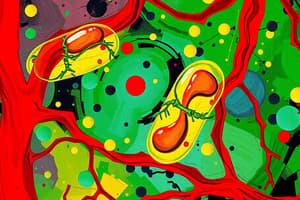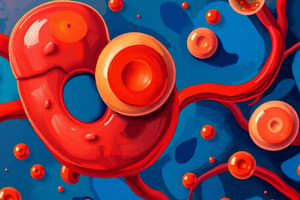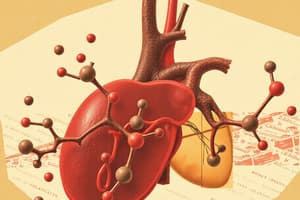Podcast
Questions and Answers
The deposition of which lipoproteins into the walls of arteries contributes directly to the formation of plaque and the development of atherosclerosis?
The deposition of which lipoproteins into the walls of arteries contributes directly to the formation of plaque and the development of atherosclerosis?
- HDL and VLDL
- VLDL, IDL, and LDL (correct)
- Chylomicrons and HDL
- Chylomicrons and VLDL
Drug therapies for cardiovascular disease commonly target lipid levels. Which of the following represents a primary goal of these therapies?
Drug therapies for cardiovascular disease commonly target lipid levels. Which of the following represents a primary goal of these therapies?
- Increasing LDL levels to ensure adequate lipid transport.
- Maintaining equal levels of LDL and HDL for balance.
- Increasing total cholesterol levels regardless of lipoprotein type.
- Lowering LDL levels while increasing HDL levels. (correct)
Cholesterol serves multiple roles within the body. Which of the following is a key function of cholesterol?
Cholesterol serves multiple roles within the body. Which of the following is a key function of cholesterol?
- Primary energy storage within cells.
- Key component of cell membranes, maintaining fluidity. (correct)
- Degradation of harmful substances in the liver.
- Major component of muscle tissue.
High levels of LDL and low levels of HDL are associated with increased cardiovascular risk. What is the MOST direct consequence of this imbalance?
High levels of LDL and low levels of HDL are associated with increased cardiovascular risk. What is the MOST direct consequence of this imbalance?
Bile acid sequestrants are a class of drugs used to lower cholesterol. What is their primary mechanism of action?
Bile acid sequestrants are a class of drugs used to lower cholesterol. What is their primary mechanism of action?
A patient is prescribed a bile acid sequestrant. They should be counselled to take other medications at least 1 hour before or 4 hours after taking the sequestrant. Why is this?
A patient is prescribed a bile acid sequestrant. They should be counselled to take other medications at least 1 hour before or 4 hours after taking the sequestrant. Why is this?
What is the primary mechanism of action of HMG-CoA reductase inhibitors (statins) in lowering cholesterol?
What is the primary mechanism of action of HMG-CoA reductase inhibitors (statins) in lowering cholesterol?
How does inhibiting HMG-CoA reductase lead to decreased levels of LDL cholesterol in the blood?
How does inhibiting HMG-CoA reductase lead to decreased levels of LDL cholesterol in the blood?
Regarding statins, which statement accurately describes the structural requirements for their activity?
Regarding statins, which statement accurately describes the structural requirements for their activity?
Lovastatin and simvastatin are administered as prodrugs. What is required for them to become active?
Lovastatin and simvastatin are administered as prodrugs. What is required for them to become active?
A patient taking lovastatin is also prescribed a CYP3A4 inhibitor. What is the MOST important consideration regarding this drug interaction?
A patient taking lovastatin is also prescribed a CYP3A4 inhibitor. What is the MOST important consideration regarding this drug interaction?
Which of the following statins is NOT metabolized by CYP3A4?
Which of the following statins is NOT metabolized by CYP3A4?
Atorvastatin has a longer half-life compared to other statins. What is a potential advantage of this?
Atorvastatin has a longer half-life compared to other statins. What is a potential advantage of this?
A patient who is prescribed medications, asks if they still need to take their statin in the evening, what is the BEST response?
A patient who is prescribed medications, asks if they still need to take their statin in the evening, what is the BEST response?
What is the primary mechanism of action of bempedoic acid in lowering cholesterol?
What is the primary mechanism of action of bempedoic acid in lowering cholesterol?
What is a notable adverse effect associated with bempedoic acid that requires monitoring?
What is a notable adverse effect associated with bempedoic acid that requires monitoring?
Ezetimibe lowers cholesterol levels through which mechanism?
Ezetimibe lowers cholesterol levels through which mechanism?
A patient taking ezetimibe is also prescribed a bile acid sequestrant. How should these medications be administered to minimize potential drug interactions?
A patient taking ezetimibe is also prescribed a bile acid sequestrant. How should these medications be administered to minimize potential drug interactions?
Fibrates primarily work by activating PPAR-alpha. What effect does this activation have on lipid metabolism?
Fibrates primarily work by activating PPAR-alpha. What effect does this activation have on lipid metabolism?
A patient is prescribed both a fibrate and a statin. Why should the prescribing physician closely monitor for potential adverse effects?
A patient is prescribed both a fibrate and a statin. Why should the prescribing physician closely monitor for potential adverse effects?
What is the mechanism of action of PCSK9 inhibitors in lowering LDL cholesterol?
What is the mechanism of action of PCSK9 inhibitors in lowering LDL cholesterol?
Lomitapide primarily inhibits microsomal triglyceride transfer protein (MTP). What is the direct result of this inhibition?
Lomitapide primarily inhibits microsomal triglyceride transfer protein (MTP). What is the direct result of this inhibition?
What distinguishes mipomersen from other lipid-lowering agents regarding its mechanism of action?
What distinguishes mipomersen from other lipid-lowering agents regarding its mechanism of action?
Which describes one of the key adverse effects of mipomersen and lomitapide?
Which describes one of the key adverse effects of mipomersen and lomitapide?
Evinacumab is a monoclonal antibody that targets angiopoietin-like protein 3 (ANGPTL3). What is the intended effect of this interaction on lipid metabolism?
Evinacumab is a monoclonal antibody that targets angiopoietin-like protein 3 (ANGPTL3). What is the intended effect of this interaction on lipid metabolism?
Niacin (nicotinic acid) affects lipid levels through multiple mechanisms. What is a primary way in which niacin impacts lipid metabolism?
Niacin (nicotinic acid) affects lipid levels through multiple mechanisms. What is a primary way in which niacin impacts lipid metabolism?
Which of the following is a common side effect associated with niacin (nicotinic acid) administration?
Which of the following is a common side effect associated with niacin (nicotinic acid) administration?
Omega-3 fatty acids primarily affect lipid metabolism by:
Omega-3 fatty acids primarily affect lipid metabolism by:
A patient with a known fish allergy needs to lower their triglycerides. Which drug is MOST appropriate?
A patient with a known fish allergy needs to lower their triglycerides. Which drug is MOST appropriate?
Flashcards
Atherosclerosis
Atherosclerosis
The deposition of lipoproteins into artery walls, forming plaque.
Good lipoprotein function
Good lipoprotein function
Promotes the removal of cholesterol from tissues to the liver for metabolism and excretion.
Bad lipoprotein function
Bad lipoprotein function
Transports lipids from the intestine and liver to tissues, potentially accumulating and sticking
Cholesterol's Role
Cholesterol's Role
Signup and view all the flashcards
Bile Acid Sequestrants
Bile Acid Sequestrants
Signup and view all the flashcards
MoA of Bile Acid Sequestrants
MoA of Bile Acid Sequestrants
Signup and view all the flashcards
HMG-CoA Reductase Inhibitors
HMG-CoA Reductase Inhibitors
Signup and view all the flashcards
Mevastatin
Mevastatin
Signup and view all the flashcards
Lovastatin
Lovastatin
Signup and view all the flashcards
Statins Mode of Action
Statins Mode of Action
Signup and view all the flashcards
CYP3A4 inhibition
CYP3A4 inhibition
Signup and view all the flashcards
Simvastatin
Simvastatin
Signup and view all the flashcards
Pravastatin
Pravastatin
Signup and view all the flashcards
Fluvastatin
Fluvastatin
Signup and view all the flashcards
Atorvastatin
Atorvastatin
Signup and view all the flashcards
Pitavastatin
Pitavastatin
Signup and view all the flashcards
Rosuvastatin
Rosuvastatin
Signup and view all the flashcards
Statin Administration
Statin Administration
Signup and view all the flashcards
Statin Side Effects
Statin Side Effects
Signup and view all the flashcards
Bempedoic Acid
Bempedoic Acid
Signup and view all the flashcards
Ezetimibe
Ezetimibe
Signup and view all the flashcards
Activation of Fibrates: PPAR-α
Activation of Fibrates: PPAR-α
Signup and view all the flashcards
Lomitapide
Lomitapide
Signup and view all the flashcards
Mipomersen Sodium
Mipomersen Sodium
Signup and view all the flashcards
Evinacumab
Evinacumab
Signup and view all the flashcards
Niacin
Niacin
Signup and view all the flashcards
Omega-3 Fatty Acids
Omega-3 Fatty Acids
Signup and view all the flashcards
PCSK9
PCSK9
Signup and view all the flashcards
PCSK9 Function
PCSK9 Function
Signup and view all the flashcards
PCSK9 Inhibition
PCSK9 Inhibition
Signup and view all the flashcards
Study Notes
- Cardiovascular diseases involve the deposition of "bad lipoproteins" like Chylomicron, VLDL, IDL, and LDL within the artery walls.
- This process forms plaque, which leads to atherosclerosis, also referred to as coronary artery disease (CHD) and cardiac diseases.
- Bad lipoproteins transfer lipids from the intestine and liver to tissues where they stick and accumulate.
- Good lipoproteins transfer lipids from tissues to the liver where they undergo metabolism and excretion.
- Drug therapy aims to lower high blood lipid levels, including cholesterol, triglycerides, and phospholipids
- Drug therapy goals involve decreasing LDL levels and increasing HDL levels.
- CHD stands for Congenital Heart Disease.
- CAD stands for Coronary Artery Disease.
Cholesterol Basics
- Cholesterol is a key component of cell membranes.
- It helps maintain cell membrane fluidity.
- Cholesterol acts as a precursor to multiple steroids.
- Normal cholesterol levels are below 170 mg/dL.
- High LDL and low HDL levels are risk factors for cardiovascular disease, increasing morbidity and mortality in CHD.
Bile Acid Sequestrants
- Bile Acid sequestrants (cholestyramine, colestipol, colesevelam) have been approved by the FDA .
- These are polymeric materials containing basic amines.
- They function by binding to bile acids like glycocholic and taurocholic acid.
- They prevent reabsorption in the GI tract and increase cholesterol conversion to bile acids.
- They are insoluble in water.
- They have a high molecular weight.
- The onset of action takes 24 - 48 hours.
- Peak effect takes 1 month.
- They have limited adverse events of constipation and possible fecal compaction
- In patients with pre-existing constipation caution is advised
- Oral medications should be taken 1 hour before or 4 hours after to prevent decreased oral absorption.
- They are not absorbed orally and are not metabolized in the GI tract.
- Instead, they are excreted in feces and complex with bile acids.
HMG-CoA Reductase
- A Key drug target in hypercholesterolemia therapy is the HMG-CoA reductase.
- It is the rate limiting step in cholesterol synthesis .
- The enzyme converts HMG-CoA to mevalonic acid.
- Mevastatin (Compactin) serves as the first HMG-CoA reductase inhibitor.
- It is a fungal metabolite identified in 1976.
- It binds with > 10,000 enzyme affinity vs HMG-CoA
- Mevastatin is Not commercialized.
- Lovastatin (Mevacor) was the first to market.
- It contains an extra methyl that doubles potency.
- Statins act as competitive inhibitors.
- They result in decreased cholesterol synthesis, increased LDL receptor expression and LDL uptake increases.
- Plasma LDL cholesterol decreases with statins.
- Lovastatin and simvastatin are pro dying.
- Caution is advised in taking with CYP3A4 Inhibitors.
- It must be monitored for liver function.
- Contraindicated in: Pregnancy, Nursing mothers.
- Should not be used in patients unable to produce LDL receptors.
- It is essential to consider risks and benefits, including development, liver function.
Specific Statins
- Atorvastatin (Lipitor/Pfizer): an upper portion “blue” Cyclic (Prodrug) or Open Ring (active drug) required for activity
- Simvastatin (Zocor) is structurally similar to Lovastatin
- It is minimal impact on properties
- Lovastatin (Mevacor/Merck) is a neutral Pro-drug
- It has low oral bioavailability of 5% (dose with food, and 33% drop if bioavailability fasting)
- it is moderate and metabolized by CYP3A4
- Pravastatin (Prevachol/BMS) It is no a pro-drug
- It can be used for patients taking CYP3A4 inhibitors
- Fluvastatin (Lescol) caution in CYP3A4 and CYP2C9 inhibitors
Studying That Suits You
Use AI to generate personalized quizzes and flashcards to suit your learning preferences.




